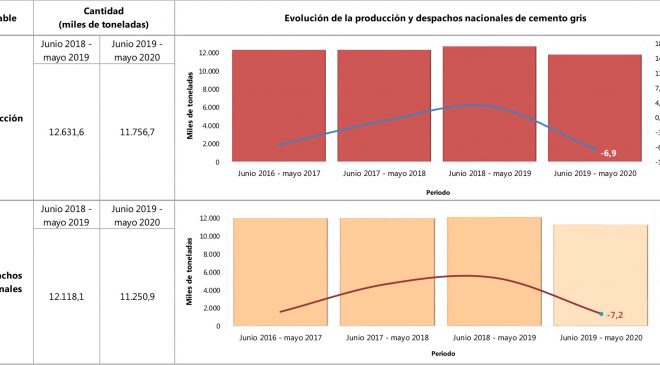The Cement Industry In Colombia And Peru Have Reactivated Thanks To The Enactment Of National Decrees.
By Mauro Nogarin
Although the current economic situation is difficult due to COVID-19, the cement industry in Colombia and Peru have reactivated their functions thanks to the enactment of respective national decrees.
The importance of the cement industry in the economy of these countries remains fundamental.
Colombia
In Colombia, according to the new technical report prepared by the National Statistics Institute (DANE), cement production nationwide in May 2020 was 778,700 tons, which represented a 30.4% decrease compared to May 2019. However, compared to April 2020, production increased 310%.
In May, 705,900 tons of cement were shipped to the national market, which meant a decrease of 33.1% compared to May 2019. However, compared to April, it was an increase of 192%.
This trend also indicates that the real estate and public works market is reactivating significantly.
Compared to the prior-year period, the result of the May total shipments of gray cement was mainly explained by the decrease in the distribution channels of the concrete industry (-52.5%) and commercialization (-22.6%) due to the stoppage of works because of the COVID-19 pandemic.
As for exports in the same month in question, they were 72,800 tons, while in April they were practically zero.
As for prices, according to a Colombian Chamber of Construction (Camacol) survey, in the last four months of 2019, cement experienced an increase of 16.5%, and until the last bulletin in May, prices remained stable.
This trend is explained after the government on April 27 enacted a series of measures to reactivate the sector, which represents 6.4% of GDP. However, these measures are far from the plan proposed by Camacol, which has a goal for the 2020-2022 period to reach 720,000 new jobs and build 500,000 formal homes and 12 million sq. meters in non-residential projects.
According to the information system of the same institution, Colombia currently has 2,600 construction projects for buildings. Of these, 90% have already resumed activities.
Peru
In Peru, the production of cement and clinker has reported negative values in the last 12 months, although in May and June, after the return of the workers to the various production plants, the industry showed an increase in production.
In fact, the new report published by the association of cement producers (ASOCEM) confirms that the accumulated production of cement in the last 12 months compared to the same period in 2018-2019 was 8,538,000 tons (-17.3%). However, registering an increase of 131.8% over the previous month with 611,000 tons.
As for the total cement dispatch, referring to the same period, it had a total of 8,405,000 tons (-15.8%), but compared to the previous month the increase was 132.5% with 595,000 tons.
Regarding cement exports, the bulletin also indicates that in the last 12 months they have suffered a reduction, reaching a total of 169,000 tons (-23%), although in May they reached a 32% increase with 6,400 tons.
Cumulative Cement Production 2019-2020 |
 |
The same trend is reflected in the new economic bulletin in the real estate market published by the Chamber of Construction of Peru (CAPECO).
The construction sector could suffer a historical decrease at the end of 2020, reaching a reduction of 40.2%, therefore, it is necessary to activate in the coming months all those measures that can limit this trend, at least by half (-20%).
In fact, a few days after the publication of this unanimous exhortation, the Martín Vizcarra government published a legislative decree that establishes special measures to reactivate, improve and optimize the execution of public and private investment projects in light of the economic impact caused by the coronavirus. The authorizations and licenses of the investment projects, which expire until Dec. 31, will be valid for another 12 months.
Mauro Nogarin is Cement Americas’ Latin American contributor. From 1997 to 2001 he was a reporter for the Italian news agency ASCA from Germany to follow the economic events of ECOFIN. At the same time, he began a strong partnership with the Italian magazine Focus with issues related to European scientific research. Back in Italy after six years of residence in the city of Heidelberg (Germany), he worked from Italy for the weekly Stern and Bild Zeitung. Since 2005, he has lived in South America (Bolivia) and worked with the Italian geopolitics review Limes, the Italian gas and oil journal Staffetta Quotidiana, the Colombian oil magazine Petroleo Internacional, the German RE Sun and Energy, the U.S. magazine Renewable Energy World (Pennwell), the World Energy Project (Università di Bologna), Pan Americana Construction magazine and Worldoil magazine. He can be reached at [email protected].

